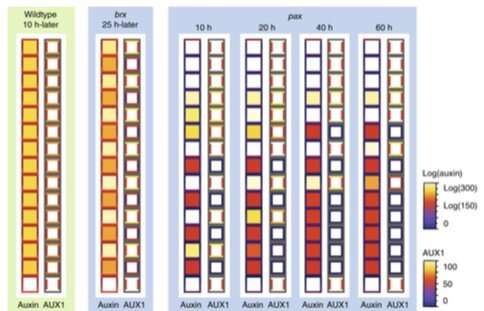How plants' vascular cells turn into holes

Theoretical biologists have solved a unique puzzle in the structure of plants' vascular tissue. Two mutations that had opposite effects appear to lead to the same result. Professor of Computational Developmental Biology Kirsten ten Tusscher has shown that both accelerating or delaying the transport of auxin through the plant's vascular tissue result in the creation of a Swiss-cheese-like pattern of holes in new vascular cells. She has published her findings in the journal Nature Communications, together with her experimental plant biologist colleagues from Switzerland.
The vascular tissue of plants transports a wide range of substances. The tissue called xylem transports water and nutrients up to the leaves, while the tissue called phloem transports sugars and the plant hormone auxin down to the roots. Mutations to the genes involved in the creation of vascular cells have a major effect on this transport of substances, and therefore plant growth, but until now scientists were unsure how these genes and mutations worked.
Theoretical biologist Kirsten ten Tusscher and her experimental colleagues in Lausanne noticed a paradoxical phenomenon: two mutations that had opposite effects both led to the same result. "One mutation made the hormone auxin flow faster out of the cells, and the other mutation actually slowed it down," explains ten Tusscher. "But both mutations resulted in the same Swiss cheese-type structure in the vascular cells."
Swiss cheese-like pattern
The Swiss cheese-like pattern is itself remarkable. The plant hormone auxin regulates the form and function of the vascular cells; "But the mutations don't make too many vessels, or none at all as one might expect," says ten Tusscher. "The plant still forms a single vessel, but one with interruptions around two cells wide every few cells."
In her research, ten Tusscher simulated the flow of auxin using a computer model, which showed that the first mutation results in a delay in the transport of auxin, comparable to a traffic jam at the top of the vessel. As a result, less auxin makes its way down the plant to where new cells are created. The other mutation, which results in an accelerated flow of auxin, makes the substance speed by like a plant hormone motorway. As a result, the auxin does not linger long enough near the cells at the bottom of the plant. Although the mutations have opposite effects on the transport of auxin, they both result in a shortage of auxin at the bottom of the vessel.
In subsequent models, Ten Tusscher showed that the pattern of holes is caused by competition for auxin among vascular cells due to the shortage of the growth hormone. Through a self-reinforcing effect in the cells, some vascular cells manage to absorb more auxin and outcompete their neighboring cells. Models of cell growth and division also show that the precise pattern of holes is far from random, as scientists had long believed.
"Now, we understand much better how the plant creates vascular tissue and why mutations in the genes we've studied have such a dramatic effect," ten Tusscher explains. "This work also emphasizes the importance of models in unraveling paradoxical results, such as opposing mutations that have the same effect or spatial patterns without an obvious explanation."
More information: Bernard Moret et al. Local auxin competition explains fragmented differentiation patterns, Nature Communications (2020).
Journal information: Nature Communications
Provided by Utrecht University Faculty of Science




















